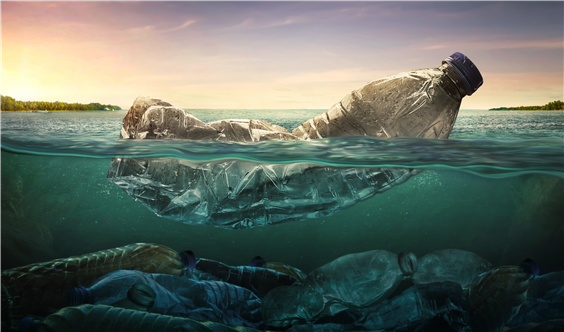
In the summer of 1997, Captain Charles Moore was passing through the middle of the North Pacific Gyre when he encountered a stretch of plastic debris surrounding the ship. For a week straight, he sailed between the pieces of plastic, all of which were plastic waste that came from the land.
What had happened to the ocean?
ㅡ
The deep and wide ocean gave us many gifts
ㅡ
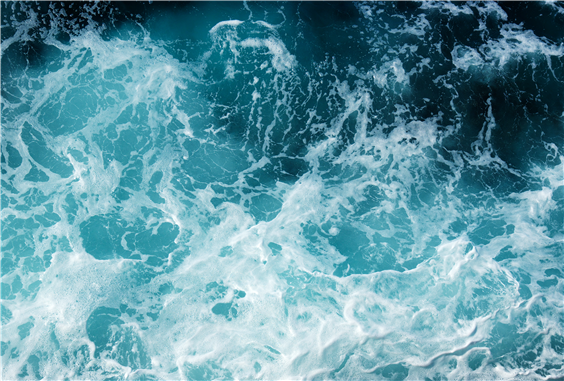
How well do you know the ocean?
l 71% of the Earth’s surface
The Earth glows blue when seen from space. This is because most of the Earth’s surface is covered by the ocean. In fact, about 71% of the Earth’s surface area is covered with water, which is equivalent to about 362 million square kilometers.
l 97% of the Earth’s water
Freshwater coming from glaciers, lakes, and rivers accounts for only about 3% of the total volume of water on Earth. Of the 3%, much less is accessible as drinking water for humans. Accordingly, technology to convert the abundant seawater into freshwater is actively being researched, developed, and applied.
l Produces 70% of the atmosphere’s oxygen
The ocean supplies oxygen, which is essential for sustaining life. Marine algae and other ocean phytoplankton produce about 70 percent of the oxygen in the Earth's atmosphere. The amount of oxygen supplied by the ocean is far greater than double the amount that is supplied by the Amazon rainforest.
l Ocean is the Earth’s air conditioner
One of the functions the ocean performs is to control the Earth’s weather. The ocean current circulates energy by moving the heat near the equator to high latitudes with less heat. The ocean acts like an air conditioner for the Earth. If the ocean currents do not perform this function, the tropics will get hotter and polar regions will get even colder.
l Repository of the tremendous amount of resources
A wide range of creatures live in the ocean and a vast array of mineral and energy resources are buried within it. The ocean has infinite potential for development. About 17,000 species of plants and about 152,000 species of animals live in the ocean, which accounts for 80 percent of the Earth's species.
The ocean also has a vast amount of energy resources such as oil and natural gas. As of 2012, approximately 30 percent of the world's oil came from offshore oil fields. In addition, energy is being produced from the ocean using the ocean tides, current, wave, and temperature differences.
The magazine Nature estimates the total annual value of land ecosystems at $10.6 trillion and the total annual value of marine ecosystems at $22.6 trillion, which is more than double the land ecosystem value. It also estimates the available use period of mineral deposits on land to be 40 to 110 years, but 200 to 10,000 years in the ocean.
ㅡ
Our ocean is becoming ill
ㅡ
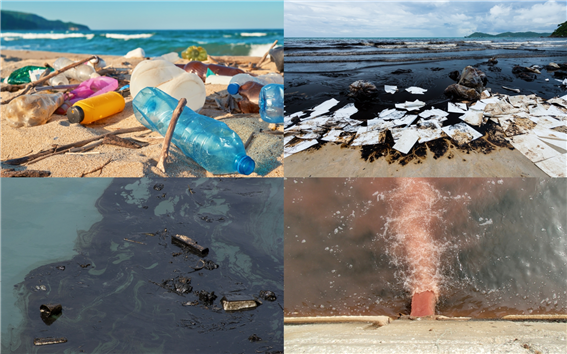
Marine pollution refers to the deterioration of water quality and other adverse effects to the ocean caused by chemicals and trash produced by human activities entering the ocean. Most pollutants produced on land will eventually reach the ocean. Among the substances that enter the ocean, pollutants with a high degree of residuality remain in the ocean and form high concentrations in the environment or inside the body of marine creatures, causing serious problems.
What is happening to the ocean?
l The ocean is getting hotter
Global warming is having a huge impact on the ocean as well as on land. For the past 100 years, the average temperature of the ocean surface has risen 0.1℃ every 10 years, and the temperature of the deep sea is rising faster than the shallow sea. Even if humankind were to stop greenhouse gas emissions right now, the temperature of the deep sea is expected to rise steadily until 2050.
l Ocean water nutrient pollution
Nutrient pollution refers to the gradual increase of phosphorus, nitrogen, and other plant nutrients causing excessive algae growth, which reduces the amount of oxygen in the water. This in turn hinders the breathing of fish and other marine life. When nutrient pollution intensifies, the blue color of the water changes to red, and fish die in droves.
l Loss of marine habitats
Marine life habitats where spawning, breeding, and growing occur are being destroyed by industrial development, pollutants, and climate change. Between 1980 and 2010, 40% of marine life habitats such as coastal wetlands, mangrove forests, sea forests, coral reefs, and mudflats disappeared or were destroyed.
l Marine life extinction
According to the 2019 Global Assessment Report on Biodiversity and Ecosystem Services, 60% of the world's marine regions are adversely affected by humans and 267 species of marine life are on the verge of disappearing.
ㅡ
What are the most common types of trash found on beaches?
ㅡ
About 80% of marine pollution comes from land, and plastic makes up the biggest proportion. Over 90% of the trash floating in the ocean is plastic. Every year, up to 12.7 million tons of plastic are thrown away into the ocean.
Seventy percent of the plastic that flows into the ocean slowly sinks below sea level. Sea creatures can swallow plastic pieces and choke to death. Pieces of plastic floating in the ocean are broken down into tiny pieces by seawater or sunlight.
The tiny pieces of plastic are called microplastic and are sometimes eaten by the fish. Once swallowed, microplastics stay in the fish for a long time and emit various harmful substances. Humans who eat these fish are also not free from the damages caused by the negative substances.
What are the most common types of trash found on beaches?
(Based on the Ocean Conservancy’s 2019 International Coastal Cleanup analysis)
1) Food packaging (4.77 million)
2) Cigarette butts (4.2 million, was the most common for 33 years)
3) Plastic bottle (1.88 million)
4) Plastic bottle caps (1.5 million)
5) Plastic straw (940,000)
Besides these kinds of trash, there are various other pollutants harming the ocean. Pesticide absorbed into the soil flows into rivers and seas, and heavy metals that are produced in the process of plating and petrochemical and automobile production flow into rivers along with sewage and wastewater eventually flowing into the sea. Large amounts of nuclear waste have also been dumped in the ocean.

△ The third Saturday of September of every year is the International Coastal Cleanup day. It began in 1986 when the environmental organization Ocean Conservancy based in Texas first started the cleanup with the support of the UN Environment Programme. Currently, about 500,000 volunteers from 100 countries worldwide participate in the cleanup making it one of the largest environmental events for the protection of the ocean.
ㅡ
The ocean is not the Earth’s trash bin
ㅡ
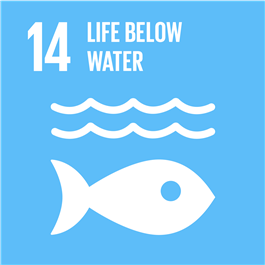
International efforts for a sustainable marine ecosystem
The causes of marine pollution and the collapse of the marine ecosystem are very complex and diverse, and the scope of causes span the entire global community. Therefore, it is important for all countries in the world to work together to come up with and implement solutions. The international community, countries, organizations, and individuals need to work together.
l International convention
Various international agreements have been signed to address the marine pollution and collapse of the marine ecosystem.
① Convention on the Prevention of Marine Pollution by Dumping of Waste and Other Matter (1972, London Convention): Convention to regulate the dumping of waste from airplanes and ships
② Global Programme of Action for the Protection of the Marine Environment from Land-based Activities (1995, GPA): The GPA was created as an intergovernmental mechanism to counter land-based pollution and its impacts on the marine environment through detailed action plans.
③ Stockholm Convention on Persistent Organic Pollutants (2001): This international environmental treaty aims to eliminate or restrict the production and use of persistent organic pollutants that do not decompose in the natural environment and accumulate in plants and animals up the food chain causing disturbance of the immune system and damage to the central nervous system.
④ Honolulu Strategy of the International Marine Debris Conference (2001): The Honolulu Strategy is a global framework to reduce the amount of marine debris produced worldwide and manage and reduce the amount and impacts of existing marine debris.
National efforts for a sustainable marine ecosystem
l Designation of marine protected areas
Countries are designating marine protected areas to protect the ocean and sustainably manage marine habitats and resources.
l Support for development of plastic alternatives
Plastic made from plant sources, such as fruit cells and corn, that are biodegradable and harmless to the human body, and other kinds of plastic alternatives is being developed.
l Encouragement and operation of the marine resources certification system
A country can support and encourage fishing companies and workers to secure seafood supplies in a sustainable manner without overfishing and illegal fishing. Furthermore, responsible and healthy consumption by consumers should be encouraged by expanding the market for seafood supplies produced in a sustainable manner.
Individual efforts for a sustainable marine ecosystem
l Reduce the use of plastic
Using reusable water bottles instead of disposable water bottles and using reusable shopping bags or baskets instead of plastic bags can make a positive difference to making our oceans healthy again.
l Participate in marine protection activities
Participating in or sponsoring marine cleanup activities hosted by good NGOs dedicated to protecting marine habitats and wildlife can also be a way to create a healthy ocean.
l Consume sustainable seafood
Some companies supply seafood in a sustainable way, while others do not. When purchasing seafood, purchase products from companies that practice sustainable fishing when possible to help protect the ocean.
ㅡ
Let’s save the ocean!
ㅡ
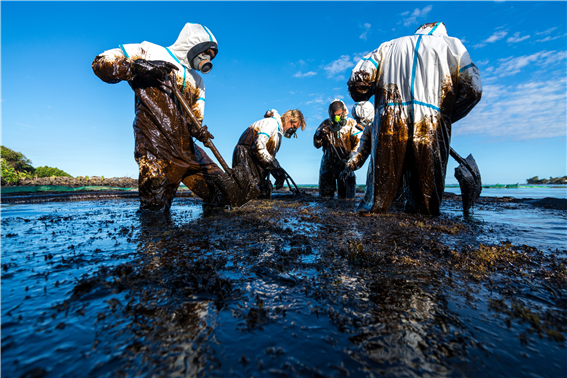
△ In July 2020, the Japanese bulk carrier Wakashio ran aground on a coral reef off the southeastern coast of Mauritius, and more than 1,000 tons of oil spilled into the sea. Volunteers are working to remove the oil off the coast of where the accident occurred.
Now is the golden time to save the ocean. The deep and wide ocean, covering 71% of the Earth’s surface, that has been providing humanity with necessities of life for a long time, is being polluted daily and slowly dying. The enormous amount of pollutants and trash that humans have let flow into the ocean has caused the ocean to lose its self-purifying ability.
Ocean pollution not only affects marine life but also affects humanity’s life. The serious problem facing the ocean is the responsibility of humanity. The only way to save the ocean is to understand clearly the dire situation of the ocean’s health and act now to improve the situation. Let us all work together to turn the polluted ocean into a healthy ocean once again.!

